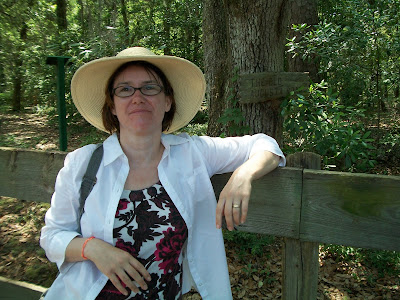It was hot and humid (as you can tell by the sheen on my face).
 They were often British -- I imagine them with their English or Celtic pallor -- so they weren't exactly used to heat and humidity.
They were often British -- I imagine them with their English or Celtic pallor -- so they weren't exactly used to heat and humidity.
Although, when you think of it, many settlers in Southeastern North Carolina did come from either South Carolina, or Barbados, so perhaps they'd gotten used to to the flies and mosquitoes and the still weight of the air by the time they settled the Cape Fear.
Still, the southern landscape really announces "you are not in England anymore."

Our trip up river from Savannah was full of swamp, heat, marsh, flies, alligators, trees, vines, and sweat.
But we weren't going so we could imagine what it was like to come here, we were going to see a particular spot, along the quiet banks of Ebenezer Creek.
 At this innocuous site, U.S. army general, the ironically-named Jefferson Davis, made a decision that led to the deaths of large numbers of ex-slaves who were following the army.
At this innocuous site, U.S. army general, the ironically-named Jefferson Davis, made a decision that led to the deaths of large numbers of ex-slaves who were following the army.Earlier this year, the Georgia Historical Society put up a roadside marker, explaining what happened at Ebenezer Creek. I'm sure the wording of the historic marker that the Georgia Historical Society put up was vetted, and fussed over, so I thought I'd let it speak for itself:
One mile north, on December 9, 1864, during the American Civil War, U.S. Gen. Jeff. C. Davis crossed Ebenezer Creek with his 14th Army Corps as it advanced toward Savannah during Gen. William T. Sherman’s March to the Sea. Davis hastily removed the pontoon bridges over the creek, and hundreds of freed slaves following his army drowned trying to swim the swollen waters to escape the pursuing Confederates. Following a public outcry, Sec. of War Edwin Stanton met with Sherman and local black leaders in Savannah on January 12, 1865. Four days later, President Lincoln approved Sherman’s Special Field Orders No. 15, confiscating over 400,000 acres of coastal property and redistributing it to former slaves in 40-acre tracts.Landscapes are like artifacts: they don't speak for themeselves. This creek's waters did not shout "history happened here." In fact, we chugged past the site the first time we reached it, and had to double back to find it.

It's not surprising that one of the soldiers who was there that day, a Colonel Charles D. Kerr of the 126th Illinois Cavalry, reputedly said "I sat upon my horse then and witnessed a scene the like of which I pray my eyes may never see again....with cries of anguish and despair, men, women and children rushed by hundreds into the turbid stream and many were drowned before our eyes."
No comments:
Post a Comment